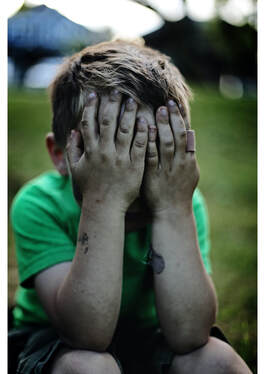Emotion Regulation in Children
by Samantha Bertoldo - Provisional Psychologist, BSc(Psych), GDipPsychAdv, MProfPsych
June 2020
by Samantha Bertoldo - Provisional Psychologist, BSc(Psych), GDipPsychAdv, MProfPsych
June 2020
|
If you are a parent, chances are you have seen your child’s emotions change from happy and loving to anger and frustration in mere milliseconds! It can happen so quickly that often you are not sure what triggered it. Maybe a toy was taken from them or they were told, “No,”? Often, when seemingly small triggers result in larger reactions than expected for their age, this may indicate emotion dysregulation.
Expression of emotion dysregulation can vary enormously from child to child. However, it is commonly expressed in the form of outbursts, tantrums, destructive or risky behaviours, withdrawal and difficulties interacting with others. It may seem as if your child has ‘lost control,’ and that no matter what you say or do, they cannot calm themselves down. It is not uncommon for very young children to throw a tantrum; hence the term, “terrible twos”! However, if your child reaches school age and they continue to exhibit emotionally uninhibited behaviours frequently, this could be a sign that they are having difficulty self-regulating their emotions. |
What is Emotion Regulation and Why is it Important?
Emotion regulation is the ability to understand and manage your behaviour and feelings in appropriate ways to meet situational demands. This encompasses resisting or controlling highly emotional reactions like frustration or excitement appropriately, calming emotions, adjusting to change, focusing on tasks, refocusing attention on a new task and controlling impulses.
It is important for a child to be able to regulate their emotions as it allows children the ability to:
It is important for a child to be able to regulate their emotions as it allows children the ability to:
- Sit, pay attention and listen for learning.
- Control impulses that may otherwise be deemed socially inappropriate. E.g. Physically lashing out if a toy is snatched away.
- Take turns in games, share toys and appropriately express emotions for positive peer socialisation.
- Reflect on behavioural choices and consequences to decide how to behave in future situations with less parental guidance.
- Manage stress by showing themselves that they can cope with uncomfortable emotions or unexpected changes through their ability to calm themselves down.
How Does Emotion Regulation Develop?
As a parent have you ever demanded your child to calm down during a meltdown? Well, depending on the child’s age, they might not physiologically be capable of regulating their emotions independently.
The part of the brain that is responsible for regulating emotions and impulse control is the pre-frontal cortex. This area is not yet fully developed in children and will not reach full maturity until the age of 25 years. This explains why children and teenagers are more likely to be impulsive and have reduced capacity for regulating their emotions.
Given that children are only at the early stages of developing emotion regulation, it can be expected that they do not yet have all the skills needed to handle some situations. Overtime, as they continue to develop, they will build upon their skills and become better equipped at regulating their emotions more independently.
The part of the brain that is responsible for regulating emotions and impulse control is the pre-frontal cortex. This area is not yet fully developed in children and will not reach full maturity until the age of 25 years. This explains why children and teenagers are more likely to be impulsive and have reduced capacity for regulating their emotions.
Given that children are only at the early stages of developing emotion regulation, it can be expected that they do not yet have all the skills needed to handle some situations. Overtime, as they continue to develop, they will build upon their skills and become better equipped at regulating their emotions more independently.
Helping your Child Learn Self-Regulation
A simple approach to supporting your child’s emotional regulation development is by viewing it as an active partnership where you are able to co-regulate and build upon your child’s regulation skills. Emotion self-regulation skills develop through warm and responsive parenting and relationships, and modelling behaviours they see from adults around them.
For some children, the development of emotion regulation does not come naturally and can require more focused support from parents. Strategies include:
For some children, the development of emotion regulation does not come naturally and can require more focused support from parents. Strategies include:
- Acknowledge and talk about your child’s emotions with them. Encourage your child to name the emotion and explain how it feels in their body. Doing this can help increase their emotional awareness so that over time your child can internally process their emotions and calm themselves down without depending on parental guidance.
- Help your child identify situations that trigger them to feel strong emotions and encourage your child not to avoid those situations, but rather support them in developing effective ways to cope in such situations. Often children find it helpful to engage in physical movement like sport or body-weight movements such as push-ups or boxing.
- Be attentive to your child’s needs. If your child needs time before talking about their feelings, redirect their attention to an activity they enjoy, and wait until they are ready to talk.
- Model appropriate self-regulation for your child. Show them that you are able to complete frustrating or challenging tasks without becoming upset.
- Give praise when your child responds effectively and appropriately to an emotionally challenging situation.
Sources
Siegel, D. J., & Bryson, T. P. (2019). The whole-brain child: 12 revolutionary strategies to nurture your child's developing mind. Brunswick, VIC: Scribe
https://raisingchildren.net.au/toddlers/behaviour/understanding-behaviour/self-regulation
https://www.achper.org.au/blog/blog-resilience-and-emotional-regulation-in-children
https://aifs.gov.au/cfca/publications/developmental-differences/emotional-dysregulation
https://www.sdn.org.au/sdn-story-hub/emotional-regulation-expressing-our-emotions/
Siegel, D. J., & Bryson, T. P. (2019). The whole-brain child: 12 revolutionary strategies to nurture your child's developing mind. Brunswick, VIC: Scribe
https://raisingchildren.net.au/toddlers/behaviour/understanding-behaviour/self-regulation
https://www.achper.org.au/blog/blog-resilience-and-emotional-regulation-in-children
https://aifs.gov.au/cfca/publications/developmental-differences/emotional-dysregulation
https://www.sdn.org.au/sdn-story-hub/emotional-regulation-expressing-our-emotions/



